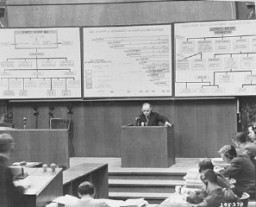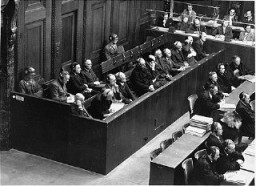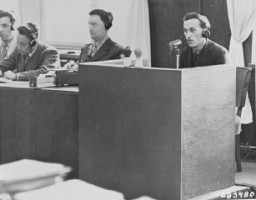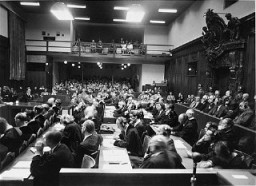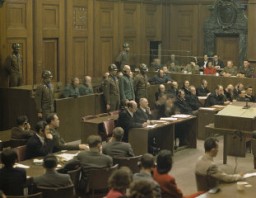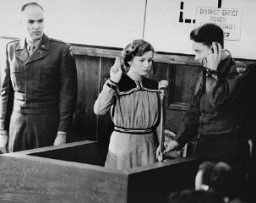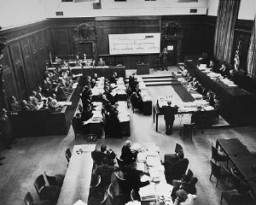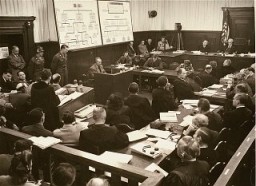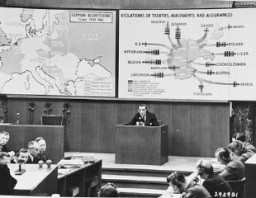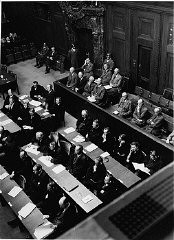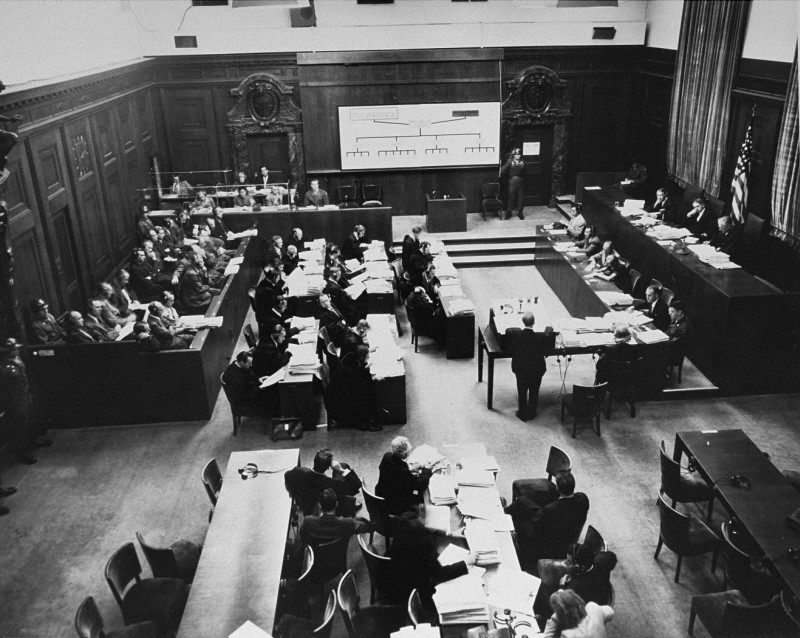
Subsequent Nuremberg Proceedings, Case #9, The Einsatzgruppen Case
After World War II ended in Europe, the Allies established an International Military Tribunal (IMT) at Nuremberg. The IMT prosecuted German leaders for international crimes defined in the Nuremberg Charter. After the IMT trial, the United States conducted twelve additional trials on the basis of the Charter. These trials are known as the “Subsequent Nuremberg Proceedings.” Case #9 of these twelve trials is known today as the Einsatzgruppen Case.
-
1
Case #9 tried leading members of the Einsatzgruppen. In 1941–1943, Einsatzgruppen conducted mass shootings of hundreds of thousands of Jews, Communists, and others during Nazi Germany’s campaign against the Soviet Union.
-
2
The United States charged 24 defendants with war crimes, crimes against humanity, and membership in a criminal organization. Twenty-two of the defendants were tried.
-
3
All 22 defendants were found guilty of at least one charge. Fourteen defendants were sentenced to death.
On September 10, 1947, the US Military Government for Germany created Military Tribunal II-A (later renamed Tribunal II). This tribunal was tasked with trying Case #9 of the Subsequent Nuremberg Proceedings: United States v. Otto Ohlendorf, et al.. Case #9 is usually referred to as the Einsatzgruppen Case.
The 24 defendants in Case #9 were all leading members of Einsatzgruppen that operated on the Eastern Front during World War II. The Einsatzgruppen were special task forces of the SS and Police. The Einsatzgruppen led by the defendants organized and conducted mass shootings of Jews, Communists, and others in territory that Germany seized from the Soviet Union.
The Indictment and Charges
On July 29, 1947, the 24 defendants in the Einsatzgruppen Case were indicted for their role in murdering between 723,661 and one million people “as part of a systematic program of genocide.” The indictment listed three charges:
- crimes against humanity
- war crimes
- membership in organizations declared criminal by the International Military Tribunal
Twenty-four Einsatzgruppen members were charged. Each one was charged with committing all three counts between June 1941 and July 1943.

The Defendants
Four of the defendants who were charged had commanded Einsatzgruppen units sent into the Soviet Union and Soviet-controlled territory as part of Operation Barbarossa in June 1941. For example, Otto Ohlendorf commanded Einsatzgruppe D while it committed mass murder in territories that are part of Romania and Moldova, as well as in Ukraine and around the Crimean Sea. The other Einsatzgruppen commanders charged in Case #9 were:
- Heinz Jost: Jost was in charge of Einsatzgruppe A. This unit perpetrated mass murder in the northernmost sector of the Eastern Front, primarily the Baltic countries and the area around Leningrad (today: St. Petersburg).
- Erich Naumann: Naumann commanded Einsatzgruppe B. This unit perpetrated mass murder primarily in Belarus and in Russian territory west of Moscow.
- Otto Rasch: Rasch led Einsatzgruppe C. This unit perpetrated mass murder in Ukraine, including the shooting of more than 33,000 Jews of Kiev at Babyn Yar.
The remaining defendants were commanders or deputy commanders of subordinate units. The men charged were: Paul Blobel, Ernst Biberstein, Walter Blume, Werner Braune, Lothar Fendler, Matthias Graf, Walter Haensch, Emil Hausmann, Waldemar Klingelhoefer, Gustav Noske, Adolf Ott, Waldemar von Radetzky, Felix Rühl, Martin Sandberger, Heinz Schubert, Erwin Schultz, Willy Seibert, Franz Six, Eugen Steimle, and Eduard Strauch.
In the end, only 22 of those charged were tried. Emil Hausmann committed suicide. Otto Rasch was deemed too ill to stand trial.
The Trial
The defendants were arraigned between September 15 and 22, 1947. The trial ran from September 29, 1947, to February 12, 1948.
The chief prosecutor was 27-year-old Ben Ferencz. Ferencz called no witnesses and based the case on wartime SS reports that detailed mass shootings conducted by the Einsatzgruppen. In his opening statement, Ferencz underscored that:
It is with sorrow and with hope that we here disclose the deliberate slaughter of more than a million innocent and defenseless men, women, and children. This was the tragic fulfillment of a program of intolerance and arrogance.…Each of the defendants in the dock held a position of responsibility or command in an extermination unit. Each assumed the right to decide the fate of men, and death was the intended result of his power and contempt. Their own reports will show that the slaughter committed by these defendants was dictated, not by military necessity, but by that supreme perversion of thought, the Nazi theory of the master race.1
Ferencz presented the case in just two court sessions. The remainder of the trial, which lasted more than three months, was devoted to the defendants’ arguments. Each defendant pleaded “not guilty.” Even those who admitted playing a role in the mass killings denied their culpability. They argued that they had acted legally and in obedience to superior orders.
The Judgment and the Sentences
The Tribunal rendered its judgment on April 8–9, 1948. It found 20 defendants guilty on all three counts. Two of the defendants were found guilty on only count three. The tribunal noted in its judgment that
the charge of purposeful homicide in this case reaches such fantastic proportions and surpasses such credible limits that believability must be bolstered with assurance a hundred times repeated.2
The sentences were announced on April 10, 1948:
- 14 defendants were sentenced to death;
- 2 were sentenced to life terms;
- and 5 received sentences that ranged from 10 to 20 years.
Matthias Graf was released with time served.
Ultimately, only four of the 14 death sentences were carried out. Ohlendorf, Naumann, Blobel, and Braune were hanged on June 7, 1951.
Eduard Strauch, the head of Einsatzkommando 2 (a subunit of Einsatzgruppe A), who received a death sentence, was extradited to Belgium. There, he was sentenced to death and died in Belgian custody.
The other defendants had their sentences commuted or were paroled. All of the remaining convicted defendants in this case were released from prison in 1958.
Series: Subsequent Nuremberg Proceedings
Critical Thinking Questions
- Beyond the verdicts, what impact can trials have?
- How were various professions involved in implementing Nazi policies and ideology? What lessons can be considered for contemporary professionals?
- How have some professional codes of conduct changed following the Holocaust?
- How did national histories, agendas, and priorities affect the effort to try war criminals after the war?
- Is it ever too late for accountability?
Allied Control Council no. 10, Trials of War Criminals before the Nuernberg Military Tribunals, vol. 4, 1950, p. 30.
Allied Control Council no. 10, Trials of War Criminals before the Nuernberg Military Tribunals, vol. 4, 1950, p. 412.
